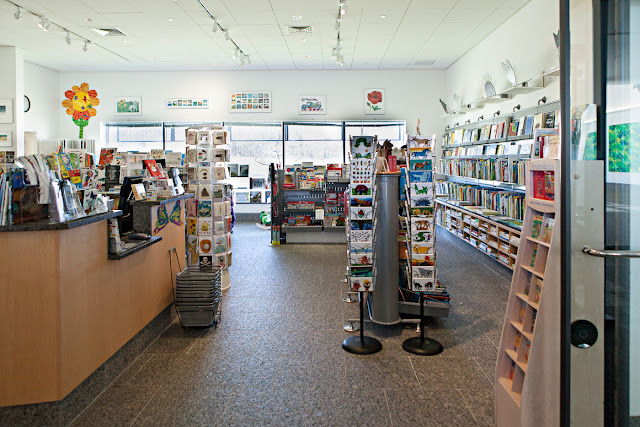Jennifer Buliszak was fortunate enough to be able to register and attend the workshop. She says,
"It was such fun to sit in the auditorium and listen to her [Bloom's] thought-provoking and eloquent booktalks (for an hour and a half) on all these fantastic new picturebooks that I was unfamiliar with previously. There was a rich discussion about the Caldecott criteria afterward.I'm sort of with Jennifer on this one -- Extra Yarn is an amazing book and a lot of fun to read and share. This book was profiled at AuthorAuthorIllustrator.blogspot.com along with comments by Michelle Edwards. You can access a PDF copy of Bloom's list of The Best of the Best in 2012 on the Eric Carle Museum's site.
The museum is such an amazing place. When I purchased my admission ticket at the front desk, the clerk cheerfully asked me which picture book I was rooting for for the 2013 Caldecott award as she was polling all the visitors that morning. I voted for Extra Yarn and she said that she has heard many votes for that title in particular."
With permission from the museum staff, Jennifer took some pictures of the exterior areas of the museum and the bookstore. Here are her pictures with some comments from me -- a lot of ideas emerge from seeing these photos.
 |
The exterior of the building provides a clue as to the white crispness
that we will see on the interior. A wonderful backdrop for the brilliant
colors of Eric Carle's art.
|
 | |
| What could be more fun than this wonderful Caterpillar Bug that serves as an official vehicle for the museum? Makes me want to purchase a "bug" for myself. |
 |
| At the front of this activity area the butterfly from The Very Hungry Caterpillar emerges in all of its brilliance. Picture this on a wall of a child's nursery/playroom. |
 |
| A wonderful idea to create unique and original papers for collages by utilizing some of the techniques used by Eric Carle. Begin with archival tissue paper and paint designs to create textured and unique papers. Eric Carle shares his technique on his website -- his slideshow of how he creates the papers is very instructive. One creative mother used the concept to allow her children to create tissue paper and collages. Take a look at The Imagination Tree: Eric Carle Tissue Paper Prints (blog entry). Using this art to make some initial pictures can provide some lovely art for a child's room. |
 | |
 |
| Note the book on the table - Eric Carle's 2012 book - The Artist Who Painted Blue a Blue Horse. The Artist Who Painted a Blue Horse, is an homage to the Expressionist painter Franz Marc. In WW11 Germany, Carle's high school teacher Herr Krauss introduced him to abstract and Expressionist art during a time when works such as these had been banned by German officials. Learn more about the title on Carle's website and view a video about the book on my YouTube channel: McElmeel101. The animal carpet in the background can be purchased from Demco.com - search for Eric Carle. A search of the Internet for Eric Carle fabric will yield some choices that will make some delightful curtains, pillows, quilts and so forth. I am particularly fond of AndoverFabrics.com which has a lot of Eric Carle fabric but also offers free patterns for several Carle themed quilts - Brown Bear, Ten Little Ducks, a Happy Birthday quilt, and others. |
I love the artwork on the left of this picture -- makes me think that blocks of fabric sewn into a simple quilt might make a great wall hanging for a stairwell. Once upon a time I wallpapered a stair well with book jackets -- that was 30 years ago and I still love that wall.
Just looking through these pictures make me want to visit the museum even more and I haven't even seen any of the displays. Thank you Jennifer Buliszak for sharing your photos with my readers (and with me). I may have to settle for making another quilt -- but Carle's work has inspired me to do something. Perhaps a name collage with tissue paper art. We'll see.













